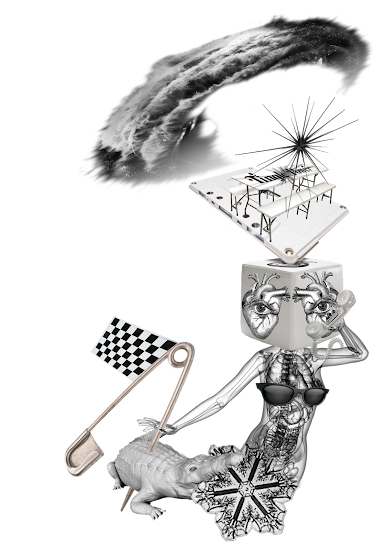Decide
if you can aesthetically abide
my deconstruction of this visual brew (for which I will-do—epistemically—be your guide).
First nucleotide -
split in two I will systematically divide
form follows function isn’t always true; as Duchamp’s R. Mutt drew and empirically descried.
This collage is comprised:
amid stickers few, one which dramatically belied
outdoor electric box-junction if circuit blew (and FAULT INDICATOR threw) was, fatalistically, inside.
Unity-service artist (oft chastized),
broad-nib scrawl indigo-blue DESIGN drips “accidentally” applied
required only, was the introduction of eyes askew - then - with no hullaballoo, to end climactically and subside.
aesthetic: a branch of philosophy focused on the nature of beauty, art, as well as subjective tastes and the creation, understanding, and appreciation of beauty.
abide: to bear-with patiently, to tolerate or withstand.
deconstruct: to examine in order to reveal the foundation or composition.
will-do (slang): informal way of saying ‘plan to accomplish’.
epistemic: of or relating to knowledge (or to validate the degree of one’s knowledge).
nucleotides form the basic structural unit of nucleic acids such as DNA.
Sullivan's famous axiom, “form follows function” (purpose should be the starting point for design) can be a touchstone for architects, artists and designers.
true (visual definition): possess ‘correct or proper alignment’.
The artist, Marcel Duchamp, is credited with coining the term ‘found art’ after submitting Fountain to an art exhibition in 1917. He signed the readymade art R. Mutt.
empirical knowledge is based on observation or experience and not on theory or logical reasoning.
descried: published, proclaimed.
belied: disguised, contradicted, a failure to give a true notion or impression.
fatalistic doctrine: all events are fixed in advance and humans are powerless to change them.
chastized: punished/ridiculed for misbehavior.
“accidentally” (usage of quotation marks): to suggest sarcasm, special insight, or imply that the opposite could be true.
askew: turned or twisted to one side, slightly off-balance.
hullaballoo: a loud, continued noise, ruckus, mixture of noises, din or cacophony of sound.
climactically: related to the end or completion, climax (with three letter Cs).
subside: settling toward the bottom, to become quiet.
Additional articles on the mechanics of poetry and art:


















































